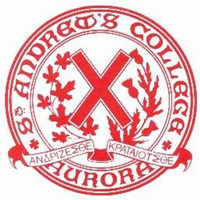



St. Andrew’s College Brings Recycling to the Classroom
Collection Stations Help School Recycling and Composting Succeed
Challenge
St. Andrew’s College, a university-preparatory school for boys, focuses on academic achievement, leadership development and a healthy dose of environmental stewardship. In 2009 the school tasked CleanRiver to help them implement a detailed and comprehensive environmental plan that included recycling and composting programs to increase their recycling and reduce food waste.
Solution
In the Dining Hall, St. Andrew’s College specified a five-compartment recycling station. This unit handles the mealtime rush with two slots for compost and two for trash, as well as a single center slot for metal, paper and plastic recyclables. Recycling stations feature specially designed graphic posters that indicate what goes where.
“We worked with CleanRiver on developing graphics that show the kind of items that students might typically have and want to get rid of. The signage helps eliminate any confusion as to what is compostable, recyclable and so forth,” says McKay.
In addition to food waste collection, St. Andrew’s recycling bins are located conveniently around the campus with clear signage to inform the community about proper recycling. It’s a single stream system for paper, glass and plastic, so the recycling stations accept all recycled materials in one opening. The school also recycles electronics, batteries and other materials. “The waste streams are matched to the hauling contract that we have negotiated. It’s different than what you would have at home, which is another reason to have clear and easily understood graphics at all recycling stations. It’s central to our goal of increasing the diversion rate,” McKay notes.
Impact
The new recycling and composting collection stations from CleanRiver helped St. Andrew’s College work towards increasing their recycling by 45% and significantly reducing food waste.
Sustainability has been wholly embraced by the entire community of approximately 700 faculty, staff and especially the students. “They are the ones who are really pushing the environmental programs,” noted Beth McKay, St. Andrew’s Director of Finance and Operations. “They’re really trying to do the right thing. We see it in the Dining Hall in particular with our composting system.”
St. Andrew’s Joins CleanRiver®’s Project Nest Box
The same plastic lumber used in the St. Andrew’s recycling containers is used in specially designed birdhouses provided by Project Nest Box, a CleanRiver program that encourages scientific observation and environmental awareness. CleanRiver Recycling Solutions manufactures the nest boxes from plastic lumber made of post-consumer recycled plastic milk jugs. From April through summer, students monitor each box and collect scientific data, which is shared with environmental organizations and agencies who conduct bird monitoring.
This year, five boxes were fully occupied by tree swallows, black-capped chickadees and house wrens. A larger box, designed for owls, has also been installed on campus. “The boys really enjoy going out in the field and watching and listening, says Robyn O’Hare, Middle School Science teacher. “With each hike out to the bird boxes they are increasing their knowledge not only of bird songs, but of species identification, mating behavior and general facts about birds,” she says.
Students have also collected data and input it online to become part of a larger study. “We have combined research into bird species with elements of the program and have incorporated into our classes,” she adds.